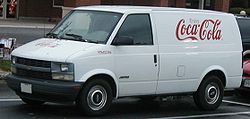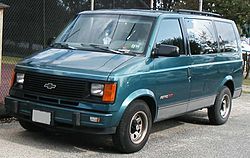- See also Chevrolet Astra of Latin America
The Chevrolet Astro was a mid-sized van introduced by Chevrolet in 1985 to rival domestic (American) competitors the Dodge Caravan/Plymouth Voyager twins. Also sharing the Astro's truck-based platform was its sibling, the GMC Safari. The Astro and Safari vans were very successful, especially with large families, conversion companies, and commercial companies. Companies liked the vans because they were also available as very roomy cargo vans, while converters used them as the basis for some very desirable small conversion vans.
| Chevrolet Astro | |
|---|---|
 | |
| Overview | |
| Manufacturer | General Motors |
| Also called | GMC Safari |
| Production | 1985–2005 |
| Assembly | Baltimore, Maryland |
| Body and chassis | |
| Class | Van |
| Body style | 3-door van |
| Platform | GM M platform |
| Powertrain | |
| Engine | 2.5 L 2500 I4 4.3 L Vortec V6 |
| Chronology | |
| Successor | Chevrolet Uplander (Astro) GMC Acadia (Safari) |
| First generation | |
|---|---|
 | |
| Overview | |
| Production | 1985–1994 |
| Powertrain | |
| Engine | 4.3 L 165 hp V6 4.3 L 200 hp V6 |
| Transmission | 4-speed automatic |
| Dimensions | |
| Wheelbase | 111.0 in. |
| Length | 177.9 in. |
| Width | 77.5 in. |
| Height | 76.2 in. |
| Second generation | |
|---|---|
 | |
| Overview | |
| Production | 1995–2005 |
| Powertrain | |
| Engine | 4.3 L 190 hp V6 |
| Transmission | 4-speed automatic |
| Dimensions | |
| Wheelbase | 111.2 in. |
| Length | 189.8 in. |
| Width | 77.5 in. |
| Height | 75.3 in. |

Both Pontiac and GMC have used the Safari nameplate (GMC is part of the Pontiac/GMC division); Pontiac used the nameplate on several of its station wagon models from 1955 through 1989. The two Safaris, both Pontiac and GMC, were on the market together (often sold by the same dealerships!) from 1985 through 1989.
Most people refer to the Astro as a minivan, although it slotted in size between the Chevrolet Venture/Lumina APV unibody minivan and the full-size Chevy Express. Similar to the Ford Aerostar, it was based on a traditional truck frame. A lot of people agree that since the van is so large, its true classification would be considered a mid-size, or "midi" van, like the Toyota Van or Ford Aerostar.
Due to their truck-based platform, the Astro and Safari were oriented more for cargo and towing; a properly-equipped Astro could pull 6,000 lb with ease. This is opposed to the car-based, front-wheel drive minivans which are considered more passenger-friendly but do not have the ability to pull as much weight (3,500 lb is the usual maximum among these).
Initial advertising boasted that it was a vehicle that will "make you realize that life is too big for a minivan", referring to the Chrysler minivans. Its specifications included a 160 to 190 hp (119 to 142 kW) V6 engine, depending on options and/or model year. It seated up to 8 passengers with optional towing capabilities.
In addition to being sold in North America, it was exported to Japan, where the van enjoys a cult following. In 2005, to celebrate the last year of Astro production, Chevrolet of Japan offered a limited edition run of the final production models. The Astro's popularity in Japan was despite the fact that it was only offered in left-hand drive.
Chassis features
Much like the second-generation GM F-body and X-body vehicles, the GM M-van (Astro/Safari) had a bolt-on subframe incorporating the front suspension from a GM B-body station wagon (Chevrolet Caprice, Cadillac Brougham) with a leaf-spring rear suspension. The lower ball joints were larger than their B-body counterparts, however. These ball joints were later used in the final Chevrolet Caprice 9C1 (police package) cars manufactured in 1995 and 1996. They also shared many mechanical similarities to the GMT 325/330 midsize S/T Pickup/Utilities.
As mentioned above, the Astro and Safari were rear-wheel drive vehicles, but in 1990 a new full-time all-wheel drive (AWD) system, designed and developed by FF Developments (FFD)[1], was made optional. This would prove popular in areas where snow was common, giving an extra measure of traction. By the end of the vans' run, many buyers were selecting all-wheel drive despite the significant penalty in fuel economy (17 miles per gallon highway versus 20-21 for rear-drive vans).
Also in 1990 a new dash was introduced along with the availability of a long-wheelbase model. In 1996, the model was facelifted with another new dash and an extended nose which resembled the new full-size Express vans. The vans remained mostly unchanged until cancelled in 2005.
In 2003, GM upgraded the chassis of both the Astro and Safari with certain suspension components, larger brakes and six-lug 16 in wheels borrowed from the full-size Chevrolet and GMC half-ton pickup trucks. The modifications improved the already-good handling and braking of the vans considerably.
End of the line
Faced with falling sales across its many vehicle lines, General Motors began closing plants and discontinuing slow-selling vehicle lines. With new federal standards for side impact and head injury reductions coming, GM determined that there was no use in expending money for a redesign of a vehicle line that was no longer selling well. Thus, the Safari and Astro were taken out of production in 2005, and the long-serving Baltimore, Maryland assembly plant where both were built was closed. It was the only mid-sized van which was produced for 20 model years - a longer run than its rival, the Ford Aerostar, which ceased production in 1997. In total, the Baltimore plant produced approximately 3,700,000 Astro and Safari vans.
In the Chevrolet line, the Astro was replaced by the Chevrolet Uplander "crossover sport van", which also replaced the Chevrolet Venture. Like the Astro, the Uplander is available in cargo and passenger versions, although it is generally not as utilitarian as the Astro, because it is a front-wheel drive unibody vehicle, some see it as less durable for heavy-duty work. Buyers looking for a commercial or industrial use van tended to purchase the larger Chevrolet Express/GMC Savana, while those looking for a personal transport or recreational van purchased the new Uplander. GMC has replaced the Safari with their Acadia 7-passenger crossover SUV for 2007.
Unsafe at any speed?
The Insurance Institute for Highway Safety (IIHS), which is known for its testing of vehicles and results that are often shown on NBC's Dateline television news program, gave the Astro a "poor" rating in 1996 because of what by all appearances was a horrifying display of structural failure in the Institute's 40-mph crash test into a fixed, offset barrier. The underbody of the test van buckled, pitching both front seats forward and shoving the crash dummy into the dashboard and steering wheel, leading the Institute to comment that "The collapse of the occupant compartment left little survival space for the driver."
In testing performed by the National Highway Traffic Safety Administration (NHTSA), however, the Astro and Safari fared better, improving from a single-star rating in 1990 to a three-star (driver) and four-star (passenger) rating by 1999. In side impacts, the Astro and Safari both received the highest, five-star, rating in every year that the test was administered.
It does appear, when one considers the results of every test that has been conducted on them, that the Astro and Safari are no less safe than other vans of similar size[citation needed]. The IIHS ratings of the Astro they tested in 1996 did not incite a major outcry among the public, although GM did continue to make small improvements to the vans as evidenced by the improved NHTSA test ratings just three years later[citation needed].
Despite the improvements borne out in the 1999 and subsequent NHTSA tests, the IIHS never tested another Astro, preferring instead to continue highlighting their test of a model that had been improved upon with regard to safety over nine succeeding model years[citation needed].
Popularity with modifiers
In addition to their popularity as conversion vans, the Astro and Safari both have popular followings with "back yard" modifiers, especially in California. Modifications are both street and offroad, and many owners prefer to replace the 4.3L Vortec V6 engine with a small-block V8 engine, most commonly the 350-cubic-inch version. It is an easy fit, as the original V6 is based on the small-block V8, and most of the factory drivetrain components can be used.
Because of its truck based design, the Astro also is popular with some off road and camping enthusiasts. The combination of a powerful drivetrain, large cargo and passenger space, all-wheel drive and stock G80 locking differential for the rear axle make this van desirable for off road modifications. With little effort the suspension can be lifted providing for larger tires and clearance with relatively small overall change in looks.
The Astro and its Safari counterpart are extremely popular in the Toronto, Canada area with teenagers, where they are known by the name "Bangbus".
Engines
External links